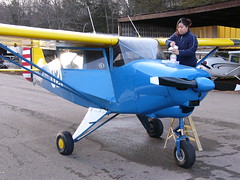Since Gail has been flying with me for a while, and taking a lot on faith, I thought I would set out to answer some questions about myself and my plane; things that I may take for granted, and have been unintentionally keeping to myself.
The plane is a 1954 Piper Tri-Pacer. I bought it in September of 2003, and flew it home from Nashville, Tennessee, in a series of adventurous flights; I was learning the quirks of the old plane on the way home, and I only had a few hours in Tri-Pacers. Compared to a brand-new four-seat plane, it's cramped and noisy, and the view is obstructed by bracing struts and wires. But it's only about 15-20 miles per hour slower, uses two-thirds the fuel, and cost a tenth of the purchase price.
The Tri-Pacer is the last of a long line of Piper aircraft that began with the famous Cub. The Cub was a two-seat lightplane with 65 horsepower, and was built in the thousands from the late 1930s. It was rugged, easy to fly and performed well on its limited power. After World War II, there was a boom in general aviation, and the Cub family began to grow in power, comfort and capability. In succeeding models the engine power was increased and the fuselage widened to accommodate four seats; with the additional performance available, the long Cub wings were shortened by three feet on either side to a total of 29 feet span. This became the "short wing" Piper family, of which the Pacer was the most powerful.
The Pacer family already had an innovation for pilots of that era, landing flaps, which were never needed on the slower long-wing Pipers. In 1951, with the increased availability of paved runways, another feature was introduced; a nosewheel. Until then, only large transport aircraft had used "tricycle" gear - all light planes had tailwheels, suited to rough fields but more challenging to take off and land. Old pilots scoffed at the "training wheel", but the new "Tri-Pacer" was a sales success, and production of the Pacer ended the next year. Piper went on to sell over nine thousand trike-geared planes over the next ten years; almost three thousand are still flying.
Like the Cubs, the Tri-Pacer was made of a frame of welded steel tubing, with sealed fabric stretched and stitched over the body and wings. It was a rugged, labor-intensive style of construction that was used on nearly every plane since the Lindbergh era. In 1961, to compete with the increasing challenge from Cessna, Piper introduced the Cherokee series. Like its rival, the Cherokee was made in an entirely new way - all metal, folded and riveted aluminum. The sleek new Cherokee could be manufactured much easier - it had only half as many parts!
My "Tripe", N1502P, has very little in common with the plane that rolled out of Lock Haven, PA back in the Buddy Holly era - other than a tail number. The paperwork for every repair and service ever done to the plane is recorded in a little stack of logbooks, going back to 1954. In the late 1950's it flipped over on landing, with only slight damage - testament to the rugged steel-tube structure. One wing was replaced at that time. Over the years it has been repaired and slightly modernized, and it's been modified many times in response to AD's - Airworthiness Directives, which come from the FAA and carry the force of law. (Want to give an aircraft owner nightmares? Whisper "Ay Dee" in his ear. They can cost thousands of dollars, and the plane is grounded until they are complied with!) The 4-cylinder Lycoming engine is nearly identical to brand-new engines; it has been completely overhauled twice, and at the last rebuild in 1998 nearly every moving part of the engine was replaced.
In the 1980s, 02P was modified with stronger wings and a heavy-duty electrical system to carry a lighted advertising sign under its belly; today, the sign has been removed. And the tough fabric covering has been replaced twice, most recently in 1992, with a synthetic fabric and plasticized coating which is far more durable than the original cotton cloth.
Even though 50 years old, it still has to pass current Federal standards for airworthiness. I am required to have it inspected every year - and the process is nothing like an auto inspection. It spends at least a week being taken apart and scrutinized by aircraft mechanics, who must sign off on everything with their name and certificate number. Parts are X-rayed, oil is chemically analyzed, and many components are replaced based on their age, not condition.
It's a fun plane to fly. The instruments and radios have been modernized, although it lacks a few items to be capable of blind-flying. It is more challenging to fly than newer planes, which have a lot of built-in aerodynamic tricks to make them tame and stable. It needs to be flown; let go of the controls, and 02P will wander off in random directions of her own choosing. But the controls respond instantly; I can only compare it to the difference between a bread truck and a little MG sportscar.
As Gail will find out - it's my hope that she will start learning to fly on the old kite, and log the time officially once I'm an instructor. It will be good to have a second pilot aboard, and she might just enjoy it as much as I do. (And if she can fly 02P, she can fly anything!)
